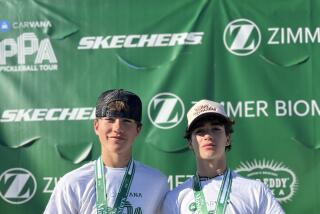A Hard-Nosed Kid Learned How From His Dear Old Mom
- Share via
Casey Candaele is a rookie infielder for the Montreal Expos. When Casey was little--wait, he still is little. When Casey Candaele was a kid, his older brothers would knock him around and rough him up in games of street football and he would rush into the house in tears.
His mom would scoot him right back out the door, back to the fray.
“It’s not that she was insensitive,” Candaele says. “She just wanted me to learn that you can’t always cry. She’s helped me all along. She knows what it’s like to play hurt, to struggle, to go into slumps. She’s been there.”
Been where? In the big leagues.
Bob Boone, Dick Schofield, Cal Ripken, Danny Tartabull and Ozzie Virgil are big leaguers whose dads were, too. But Casey Candaele--pronounced can- dell --is the first major leaguer whose mother was a big league baseball player.
When America’s men went to war in the early 1940s, owner P.K. Wrigley of the Chicago Cubs filled the baseball void by creating a national women’s softball league. It soon evolved into full-scale hardball, the All-American Girls Baseball League, with teams throughout the Midwest. They played 8 games a week, 115 a season. The league lasted from 1943 to ’54 and drew a million fans a year.
The players were sent to a mandatory charm school. They wore makeup and were forbidden to drink or smoke. On the field, they wore sexy little cheerleader-type skirts. They also wore regular baseball spikes, ran the bases like Pete Rose and developed a number of truly talented stars.
Helen Callaghan was one. A pint-sized (5 feet 1 inches, 105 pounds) teen-ager from Canada, Helen signed with the Minneapolis Millerettes in ’45. She also played for the Minneapolis Orphans, a traveling team that continued when the original franchise folded; the Fort Wayne Daisies and the Kenosha Comets.
Helen was soft-spoken but intense and aggressive. She played center field and hit with power and authority. One old newspaper clip refers to her as “a feminine Ted Williams.”
Helen retired after four seasons in the league, to get married and have children. She had five, the last of whom was Casey. From her, Casey inherited his stature (5-8, 160) and his attitude.
“He was always small and skinny,” says Helen St. Aubin (she remarried). “I didn’t think he’d ever be a great star in sports. It never entered my mind. But my sons have always loved sports, and I knew if Casey wanted to be good, he would have to be aggressive. I don’t mean being able to whip other kids, but being tough within himself.”
Casey’s dad left the family, in Lompoc, Calif., when Casey was getting to be of Little League age. So mom would take her youngest son to the park regularly, play catch with him, hit him fungoes, teach him fundamentals, show him the little tricks of the trade. She did it patiently and quietly, in her tiny, sparrow-like voice.
“I just thought everyone’s mom was out there teaching them how to play baseball,” Casey says. “I didn’t know until I was in high school that she ever played baseball. She never talked about it. Then she started getting letters about reunions of this women’s league, and we’d say, ‘What’s this, Mom? Softball?’ Then she told us all about it.
“I’m really proud of it. A lot of guys I played ball with, their dads played pro ball. I tell them my mom played, too. They go, ‘What, softball?’ ”
Casey’s mom was a star in the women’s league, earning as much as $125 a week. She’s one of the featured players in a half-hour documentary, “A League of Their Own,” that will be shown March 28 and 29 on KCET-TV. The show features old newsreel and film clips, and recent reunion footage. The show is co-produced by Kelly Candaele, one of Casey’s four older brothers.
Casey is not a star in his league. Last season, his fourth in pro baseball, he was called up to the Expos twice, started 30 games and hit .231. Right now, he’s battling for the second base job, and he isn’t even a lock to make the team.
Candaele doesn’t have much power. He swings a 31-ounce bat, as compared to mom’s old 36-ounce war club, which was the biggest bat in the AAWBL, and which she gripped at the very bottom. But Casey is one of those scrappy players, a pig-pen type who gets his uniform dirty between the clubhouse and the dugout.
Plus, there’s something about him. He has this relentlessly upbeat attitude and quiet intensity. If Casey does make it in the big leagues, it will be because he plays like a girl. A girl named Helen.
More to Read
Go beyond the scoreboard
Get the latest on L.A.'s teams in the daily Sports Report newsletter.
You may occasionally receive promotional content from the Los Angeles Times.










